Easy Butter Bean Stew

This stew is basically comfort food’s answer to “I want something hearty but don’t want to spend my entire evening in the kitchen.”

We’re talking about a one-pot wonder that transforms humble pantry staples into something that tastes like you’ve been simmering it all day, when really you’ve been binge-watching Netflix for most of that time.
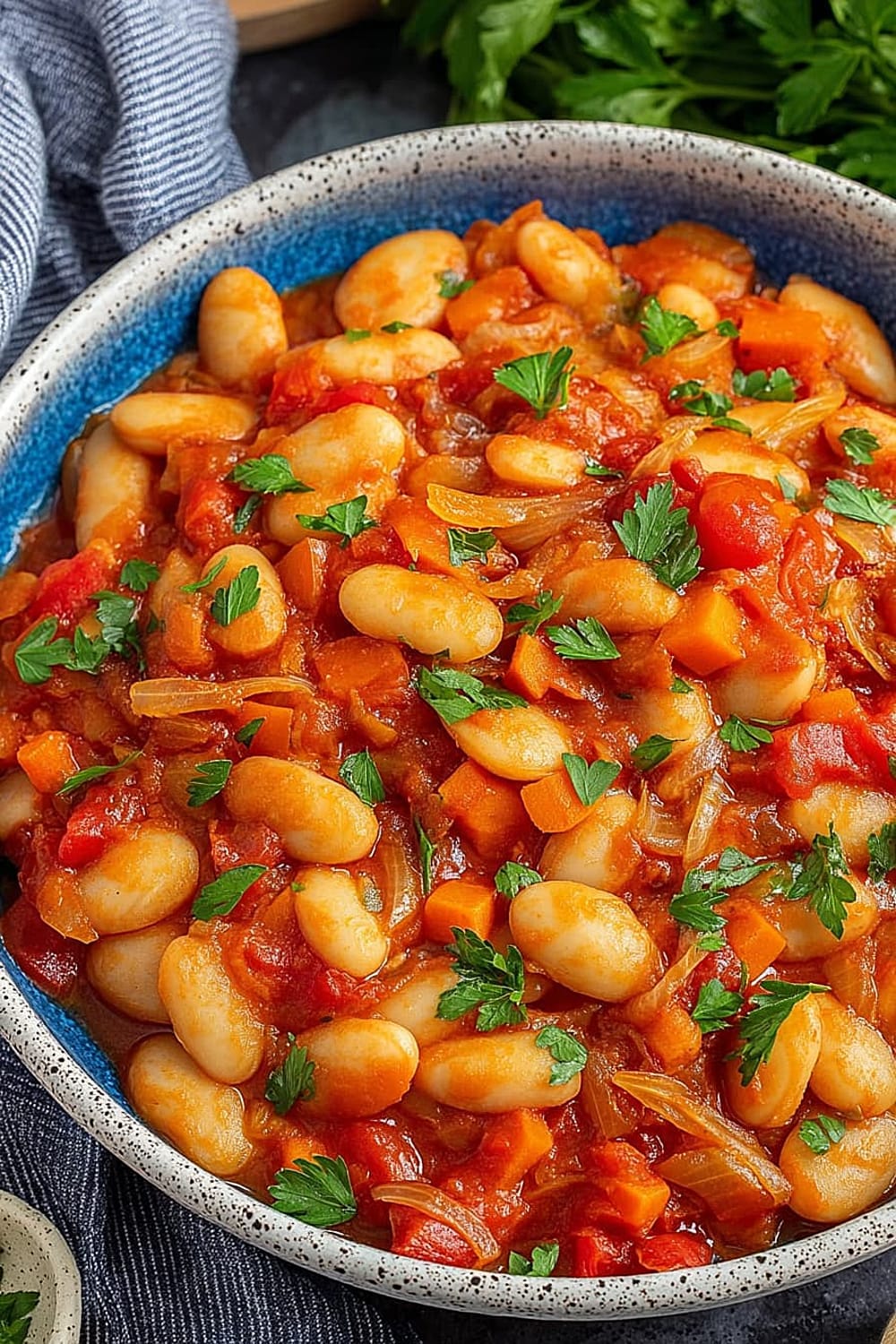
The butter beans get perfectly creamy without any mashing or blending, while the vegetables create this amazing base that’s both rustic and sophisticated at the same time.
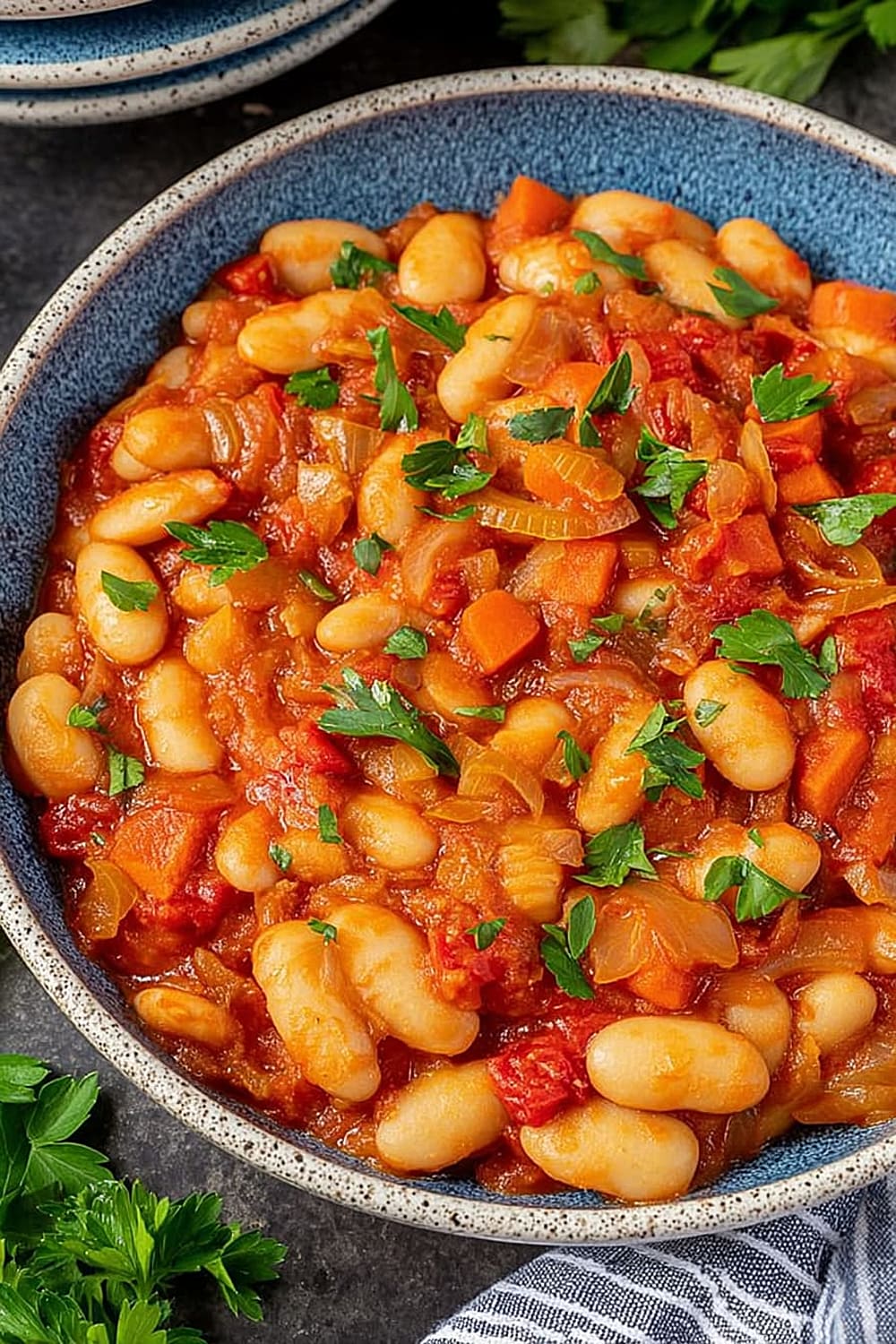
Plus, your kitchen will smell like an Italian grandmother has been cooking in there all afternoon, which is basically the ultimate flex.

This recipe is proof that you don’t need fancy ingredients or complicated techniques to create something that makes people go “Wait, you made this from scratch?”
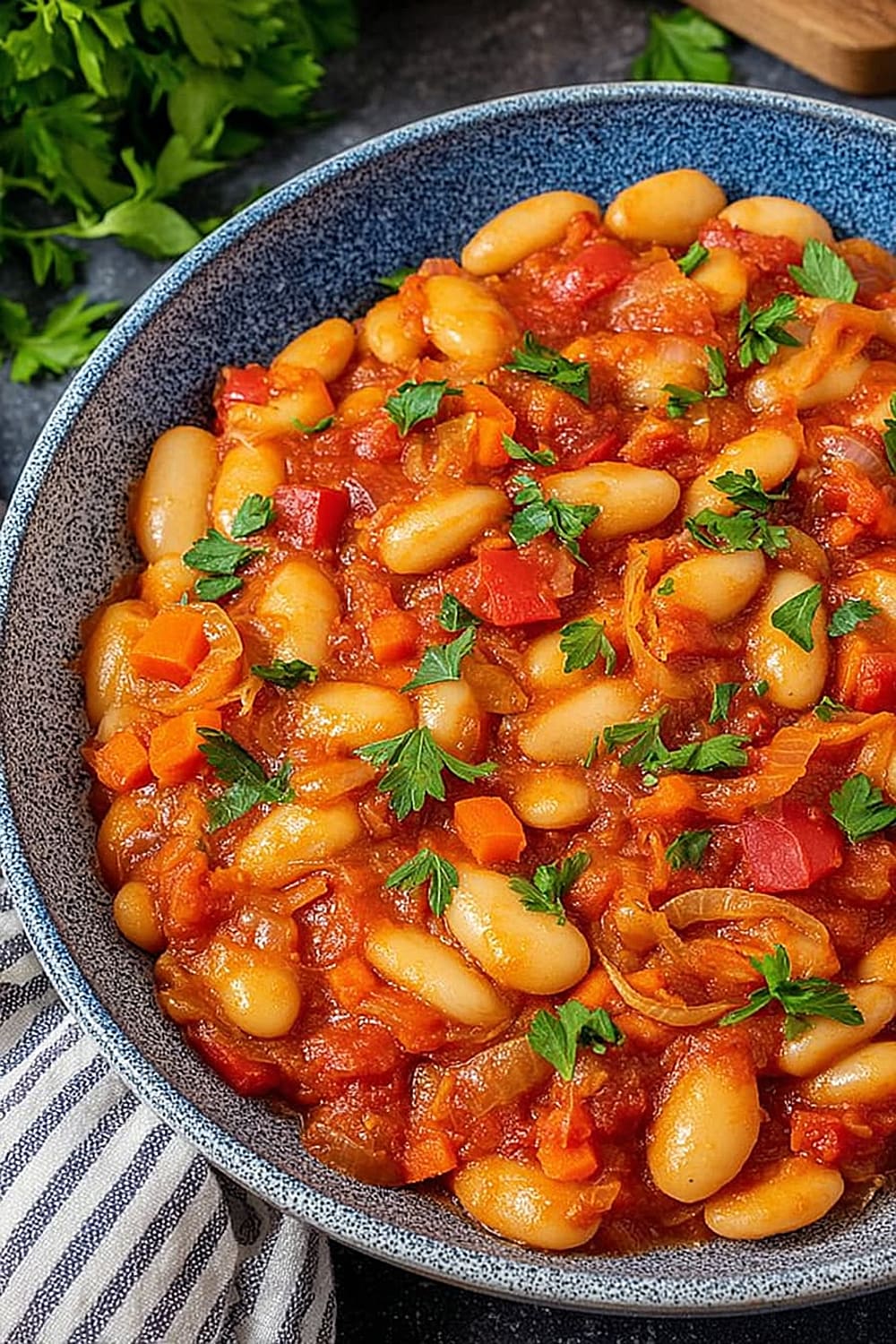
Prepare yourself for requests for the recipe, because this stew has that magical quality of tasting way more complicated than it actually is.
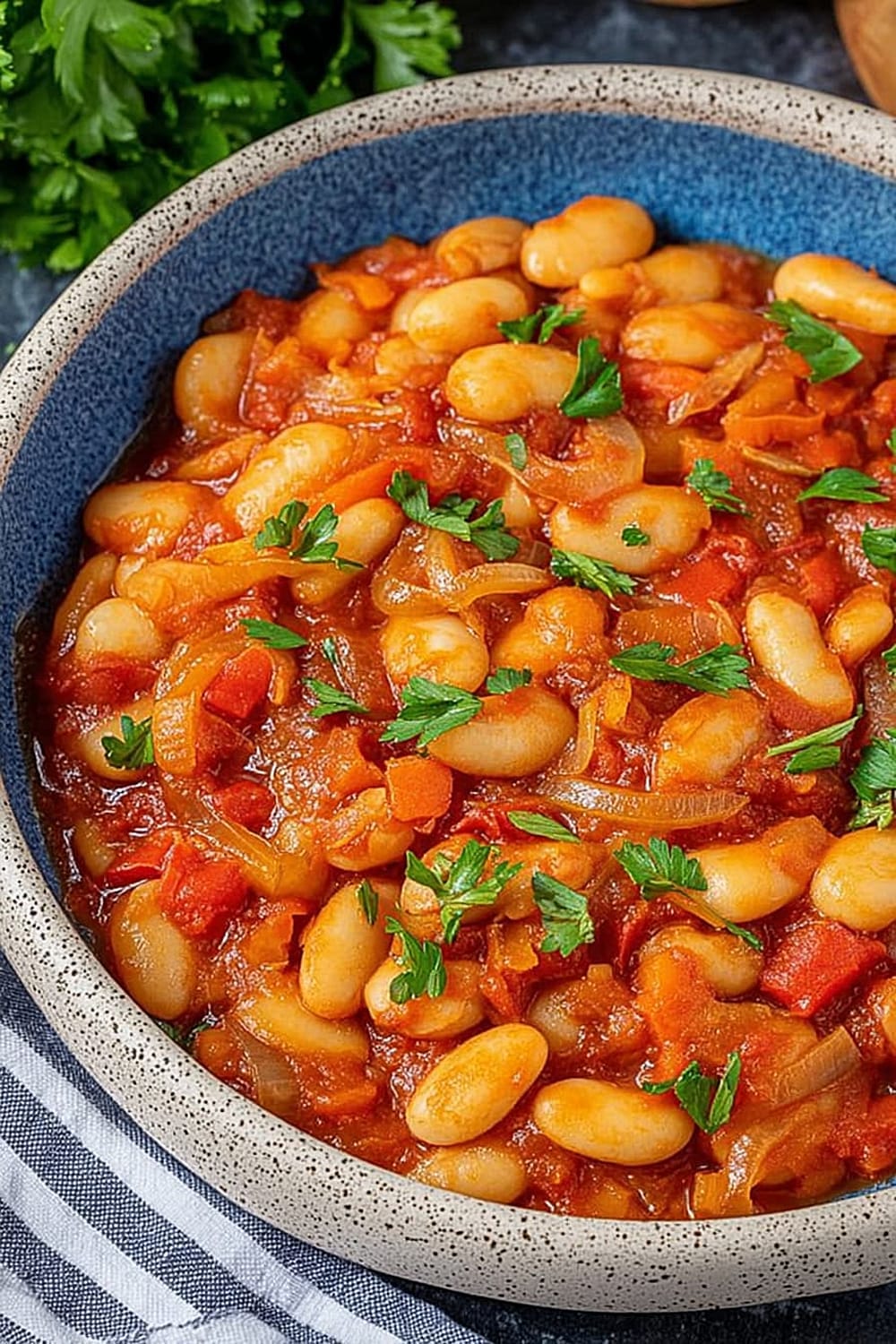
Ingredients
For the vegetable base
- 1 tablespoon olive oil (extra virgin olive oil adds exceptional flavor)
- 1 large red onion, diced
- 1 large carrot, diced
- 1 large red pepper, diced
- 4 garlic cloves, finely chopped
For the flavor foundation
- 1 tablespoon fresh rosemary, finely chopped
- 1 tablespoon tomato paste
- 200 ml (1 cup) vegetable stock (organic vegetable stock enhances the overall taste)
For the stew base
- 1 x 400g (14 oz) can chopped tomatoes
- 2 x 400g (14 oz) cans butter beans, rinsed and drained
- 1-2 tablespoons fresh parsley, chopped
- Salt and pepper to taste
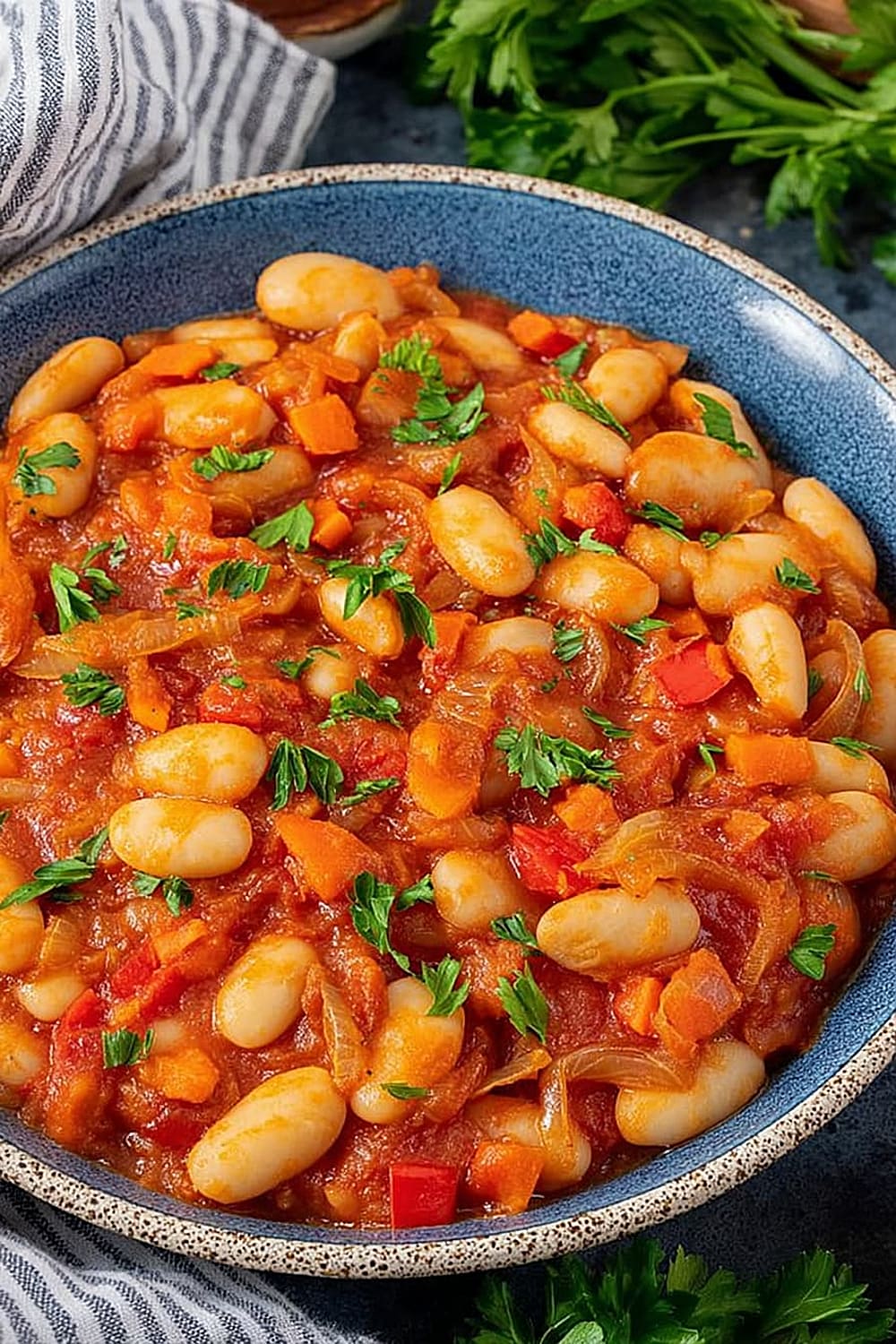
Instructions
Prepare the vegetable base
- 1 Heat the olive oil in a large, deep pan with a lid over medium heat. A cast iron skillet or heavy-bottomed Dutch oven works exceptionally well for even heat distribution and superior browning.
- 2 Add the diced red onion, carrot, and red pepper to the pan. Sauté for 3-5 minutes until the vegetables begin to soften and the onions become translucent. You’ll know they’re ready when the vegetables release their natural sweetness and the onions lose their sharp bite.
Build the flavor foundation
- 3 Stir in the finely chopped garlic and fresh rosemary, cooking for another minute until fragrant. The garlic should become aromatic but not brown – if it starts browning, reduce the heat slightly. This step is crucial for developing the stew’s depth of flavor.
- 4 Add the tomato paste and stir continuously for 30 seconds to cook out the raw tomato flavor. This technique, called “blooming,” intensifies the tomato paste’s umami qualities and prevents any metallic aftertaste.
Complete the stew
- 5 Pour in the vegetable stock, chopped tomatoes, and drained butter beans. Stir everything together, ensuring the tomato paste is fully incorporated. Bring the mixture to a gentle simmer – you should see small bubbles breaking the surface consistently.
- 6 Cover the pan with a lid and reduce heat to low-medium. Simmer for 10 minutes, allowing the flavors to meld and the beans to heat through completely. The stew should be bubbling gently but not vigorously boiling.
- 7 Remove from heat and stir in the fresh parsley. Season generously with salt and pepper to taste. Serve immediately with crusty bread or a fresh green salad for a complete, satisfying meal.
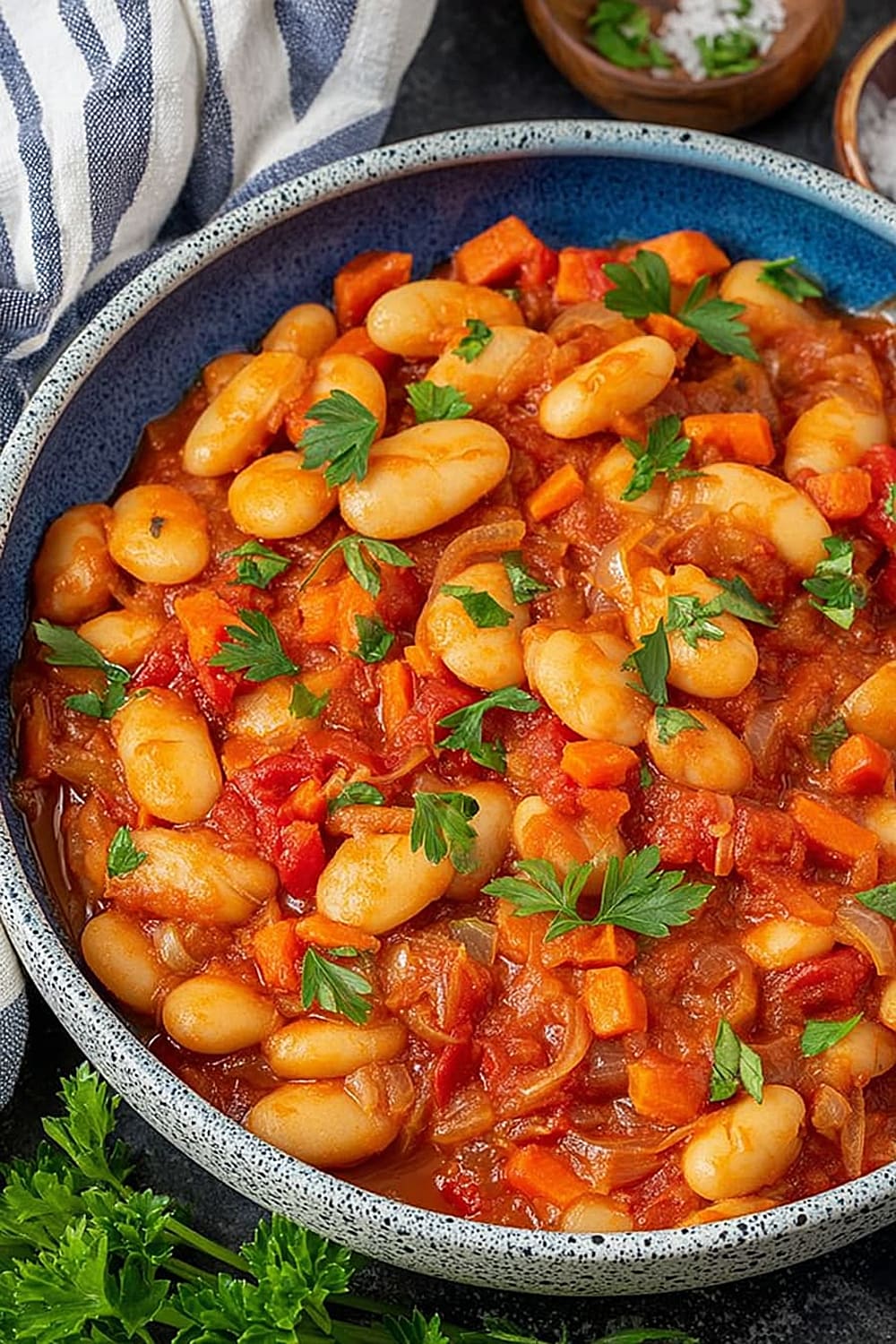
Recommended Equipment and Kitchen Tools
Recommended Tools (for best results):
- Large, deep pan with lid – A cast iron skillet or Dutch oven provides superior heat retention and even cooking, preventing hot spots that could burn the vegetables
- Sharp chef’s knife – Essential for efficiently dicing vegetables to uniform sizes, ensuring even cooking throughout the stew
- Cutting board – A large wooden or bamboo cutting board gives you ample space for prep work and protects your knife’s edge
- Wooden spoon – Perfect for stirring without scratching non-stick surfaces and won’t conduct heat like metal utensils
Helpful Upgrades:
- Immersion blender – If you prefer a partially blended texture, you can pulse the stew a few times for a creamier consistency while maintaining some chunky texture
- Kitchen scale – For precise measurements, especially when scaling the recipe up for meal prep or entertaining larger groups
- Microplane grater – Ideal for zesting citrus or grating fresh garlic directly into the pan for maximum flavor impact
Nice-to-Have Options:
- Food processor – Makes quick work of dicing vegetables uniformly, especially helpful when making larger batches for meal prep
- Storage containers – Glass containers with tight-fitting lids are perfect for storing leftovers and reheating portions throughout the week
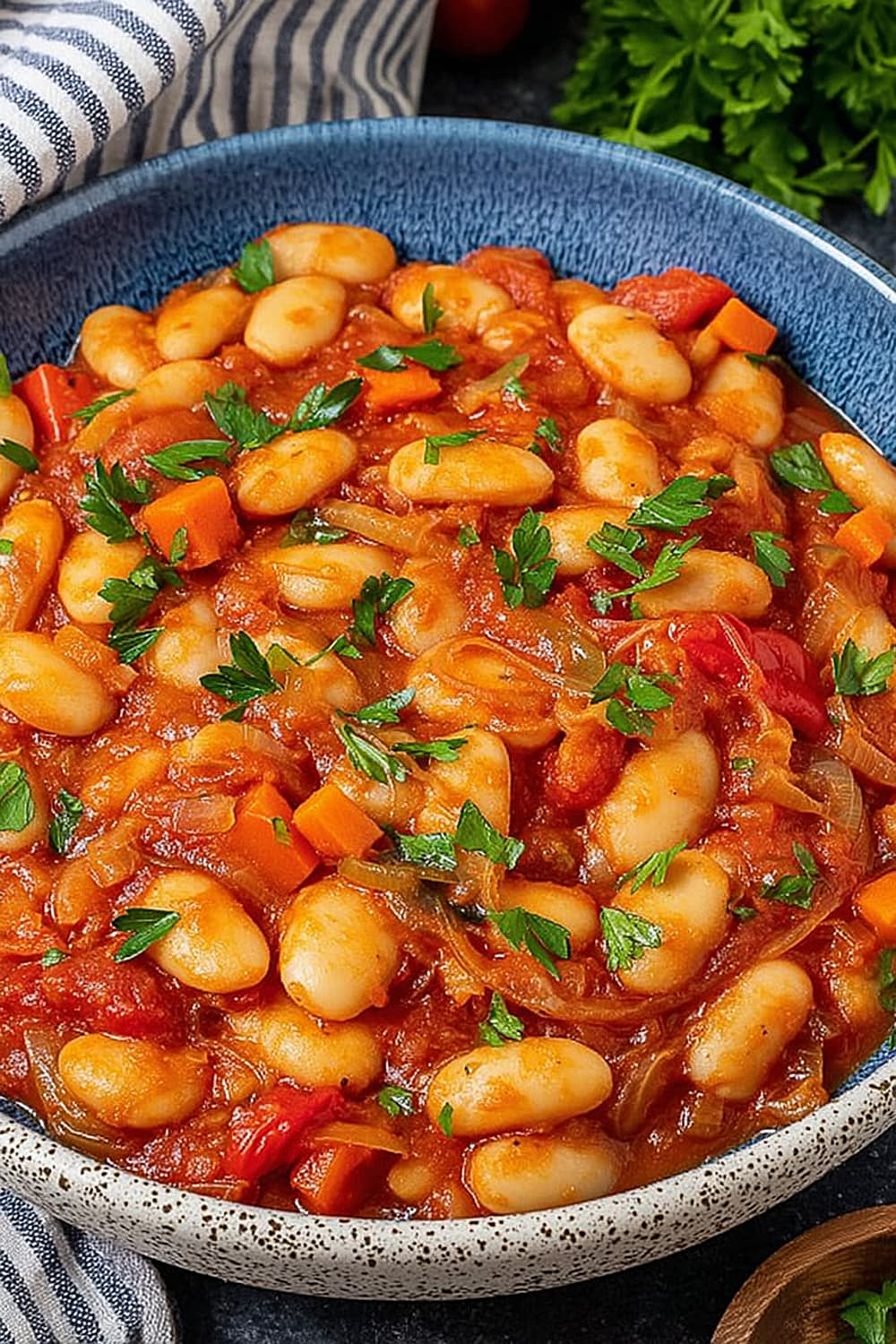
Recipe Variations and Dietary Modifications
Protein Additions:
- Add 1 cup cooked Italian sausage or diced pancetta with the vegetables for a heartier, more substantial meal
- Stir in 2 cups fresh spinach or kale during the last 2 minutes of cooking for added nutrients and color
- Include 1 cup cooked white beans or chickpeas alongside the butter beans for extra protein and texture variety
Spice and Herb Variations:
- Replace rosemary with 1 tablespoon fresh thyme or 2 teaspoons dried oregano for a different Mediterranean flavor profile
- Add 1 teaspoon smoked paprika and 1/2 teaspoon cumin for a Spanish-inspired twist with smoky depth
- Include 1/4 teaspoon red pepper flakes with the garlic for a gentle heat that builds throughout the dish
Seasonal Adaptations:
- Summer version: Add 1 diced zucchini and 1 cup cherry tomatoes for fresh, garden-style flavors
- Winter variation: Include 1 cup diced butternut squash and 1 teaspoon fresh sage for warming, cold-weather comfort
- Spring option: Stir in 1 cup fresh peas and 2 tablespoons fresh mint during the last 3 minutes of cooking
International Flavor Profiles:
- Moroccan-inspired: Add 1 teaspoon ground cinnamon, 1/2 teaspoon ground ginger, and 1/4 cup dried apricots
- Indian-spiced: Include 1 teaspoon curry powder, 1/2 teaspoon turmeric, and 1 can coconut milk instead of some stock
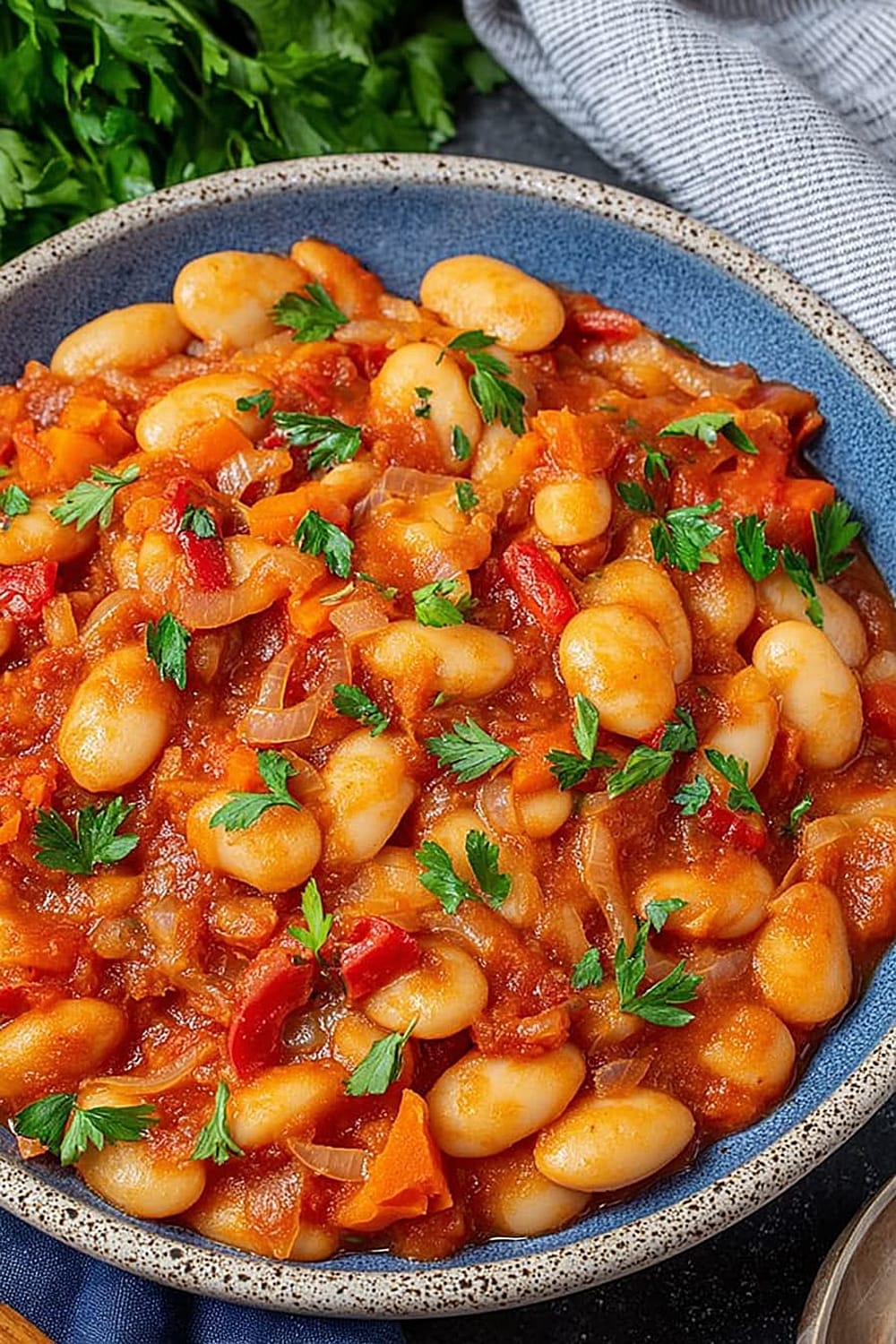
Nutritional Information and Health Benefits
Key Nutritional Highlights:
This butter bean stew provides approximately 280-320 calories per serving when divided into 4 portions. The dish is naturally high in plant-based protein (about 12-15 grams per serving) and dietary fiber (8-10 grams), making it incredibly satisfying and beneficial for digestive health. The combination of beans and vegetables provides complex carbohydrates that offer sustained energy without blood sugar spikes.
Health Benefits of Main Ingredients:
Butter beans are nutritional powerhouses, packed with folate, magnesium, and potassium. They’re excellent sources of soluble fiber, which helps lower cholesterol levels and promotes heart health. The antioxidant-rich vegetables – particularly the red pepper and tomatoes – provide significant amounts of vitamin C, beta-carotene, and lycopene. Fresh rosemary contains rosmarinic acid, a powerful anti-inflammatory compound that supports cognitive function and immune health.
Dietary Considerations:
This stew is naturally vegan, gluten-free, and dairy-free, making it suitable for most dietary restrictions. It’s also low in saturated fat and contains no cholesterol. The high fiber content promotes satiety, making it an excellent choice for weight management. The combination of protein and complex carbohydrates makes this dish particularly beneficial for blood sugar stability and sustained energy levels throughout the day.
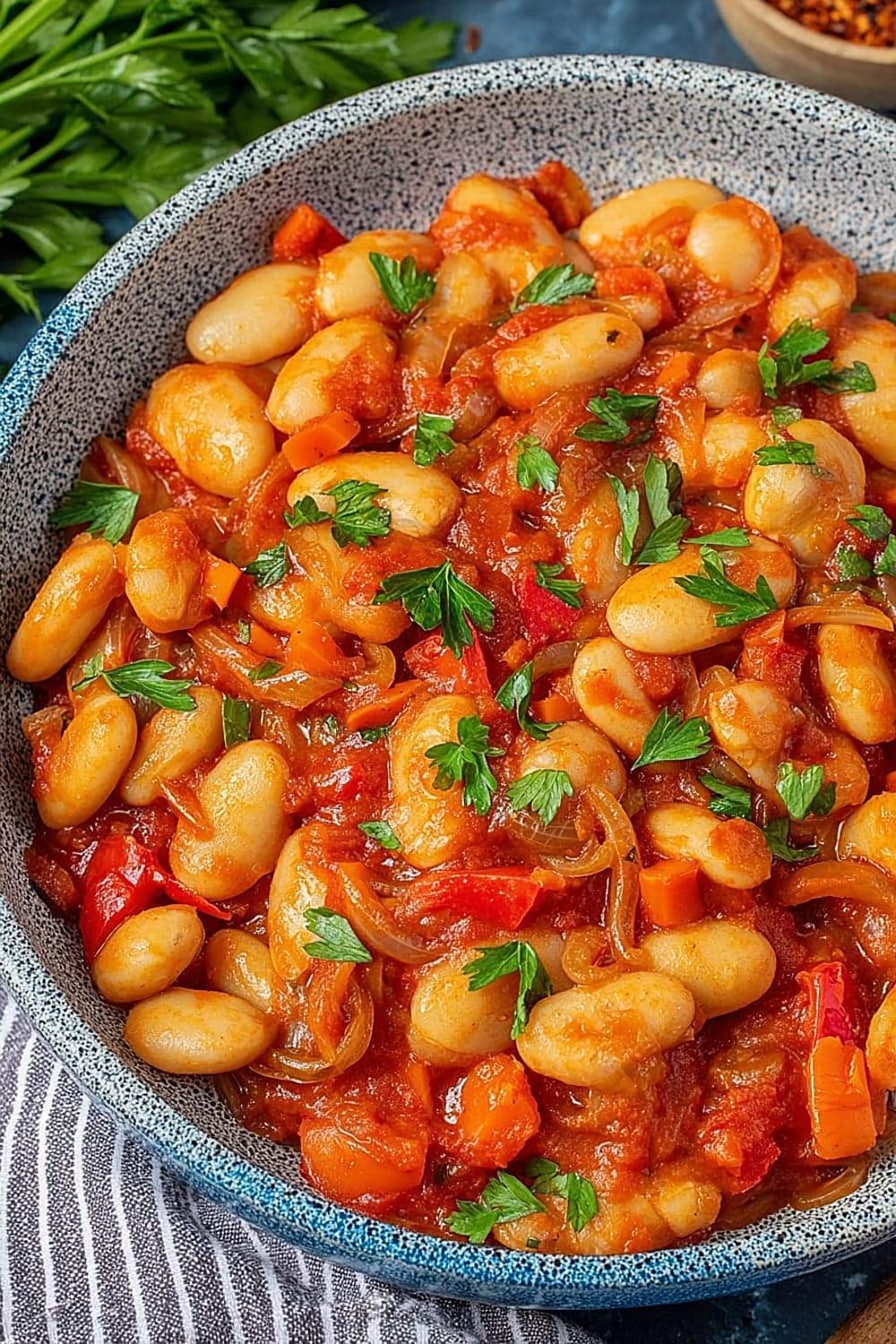
Smart Swaps and Ingredient Substitutions
Common Substitutions:
- Butter beans → Cannellini beans, great northern beans, or lima beans work equally well and provide similar creamy texture
- Fresh rosemary → 2 teaspoons dried rosemary or 1 tablespoon fresh thyme for similar earthy, aromatic qualities
- Vegetable stock → Chicken stock for non-vegetarian versions, or water with 1 bouillon cube for budget-friendly options
- Red pepper → Yellow bell pepper or 1 cup diced celery for different flavor profiles and textures
Budget-Friendly Swaps:
- Canned tomatoes → 2 cups fresh tomatoes, diced when in season and on sale, though cooking time may need adjustment
- Fresh herbs → Dried herbs using 1/3 the amount (so 1 teaspoon dried instead of 1 tablespoon fresh)
- Organic vegetables → Conventional vegetables still provide excellent nutrition and flavor at lower cost
Pantry Emergency Substitutions:
- Tomato paste → 2 tablespoons ketchup or 1/4 cup tomato sauce reduced by half through cooking
- Red onion → Yellow onion, white onion, or even 3 shallots for similar foundational flavors
- Fresh parsley → Fresh cilantro, basil, or even green onion tops for bright, fresh finishing notes
Pro Tips for Substitutions:
- When using dried beans instead of canned, soak 1 cup dried butter beans overnight and cook until tender before adding to the stew
- Store leftover tomato paste in ice cube trays for future single-tablespoon portions
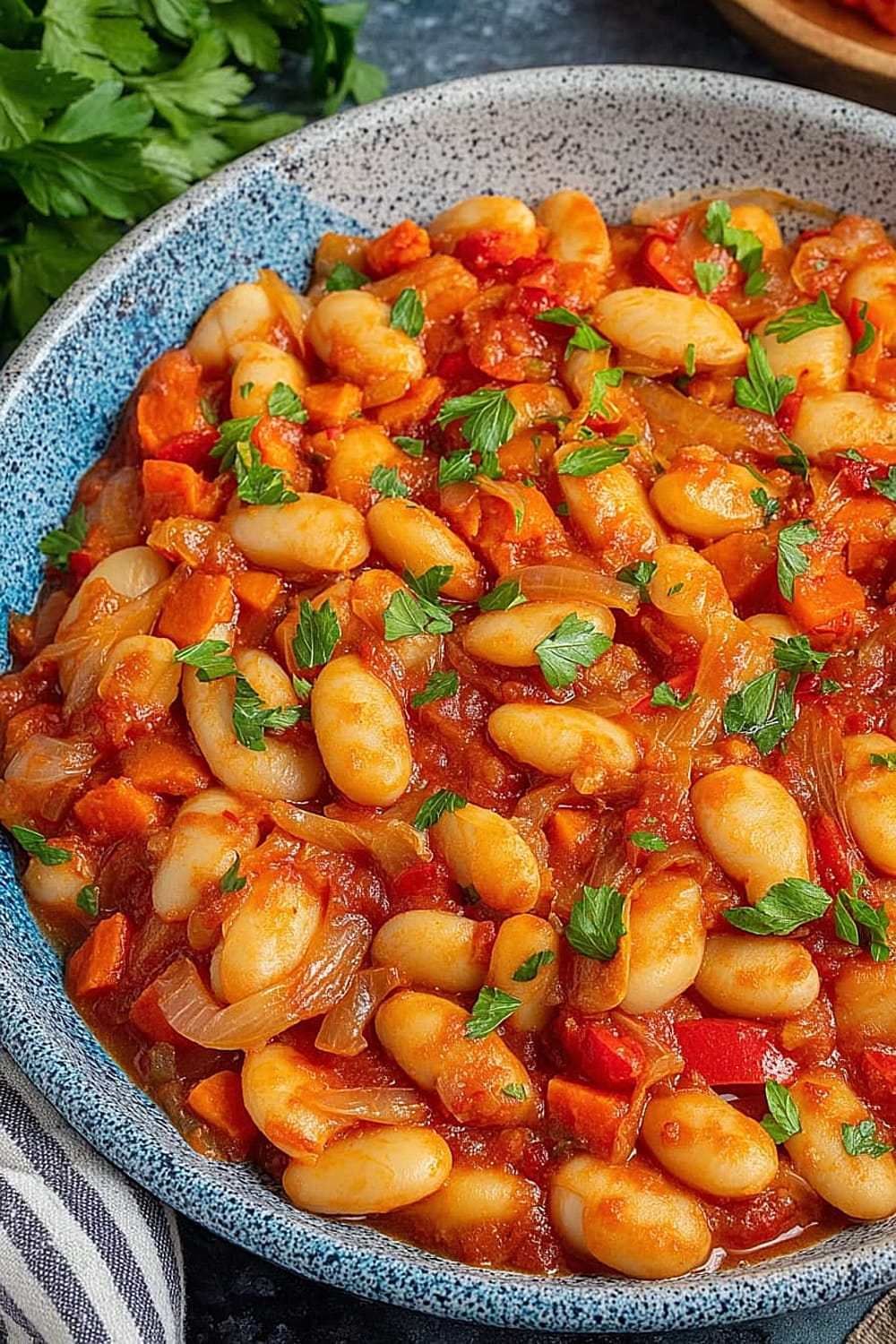
Make It Diabetes-Friendly
Carb-Conscious Modifications:
- Reduce butter beans to 1 can instead of 2, and add 2 cups cauliflower florets or diced zucchini to maintain volume while cutting carbohydrates by approximately 15-20 grams per serving
- Add extra vegetables like bell peppers, mushrooms, or leafy greens to increase fiber and nutrients while keeping carbs minimal
- Include 1 cup cooked lean protein such as diced chicken breast or turkey to help stabilize blood sugar response
Portion & Timing Tips:
- Serve 1 cup portions alongside 2-3 oz lean protein and 1 cup non-starchy vegetables for balanced macronutrients
- Estimated carbs per serving: Approximately 25-30 grams with modifications, 35-40 grams in original recipe
- Pair with healthy fats like 1/4 avocado or 1 tablespoon olive oil drizzle to slow carbohydrate absorption
- Best timing: Serve as lunch or early dinner when insulin sensitivity is typically higher
Blood Sugar Management:
- Add extra fiber with 1 tablespoon ground flaxseed or chia seeds stirred in after cooking
- Include cinnamon (1/2 teaspoon) which may help with glucose metabolism
- Monitor portion sizes and consider splitting servings if blood sugar response is higher than desired
Total Carb Reduction: Modified version reduces carbohydrates by approximately 30-35% compared to original recipe while maintaining satisfying portion sizes.
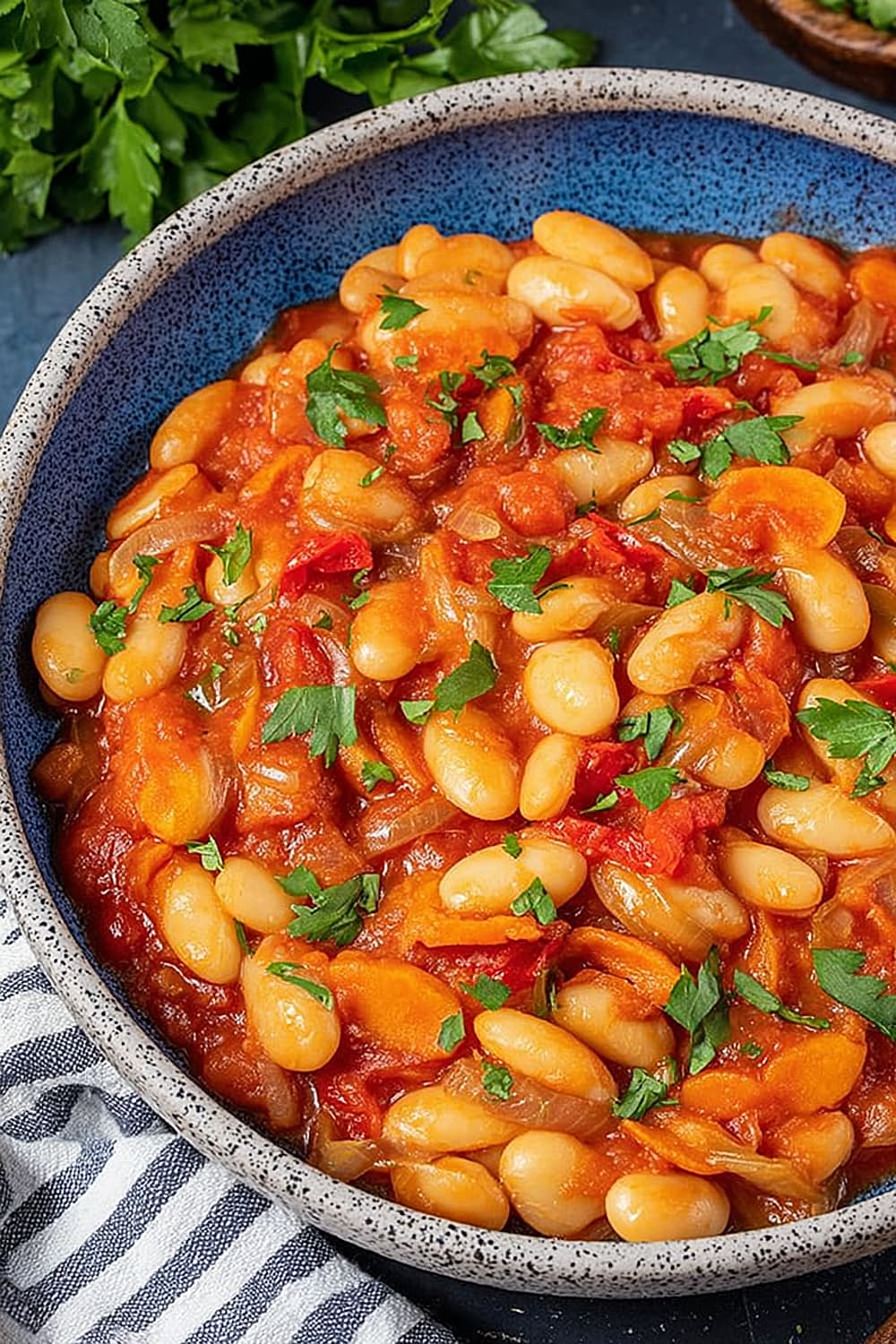
Perfect Pairing Suggestions
Beverage Pairings:
This hearty stew pairs beautifully with medium-bodied red wines like Chianti or Sangiovese, which complement the tomato base without overpowering the delicate bean flavors. For white wine lovers, a crisp Sauvignon Blanc or Pinot Grigio provides refreshing contrast to the rich, earthy flavors. Non-alcoholic options include sparkling water with lemon, herbal teas like chamomile or mint, or fresh-pressed vegetable juices that echo the stew’s garden-fresh qualities.
Side Dish Recommendations:
Crusty sourdough bread or artisanal whole grain rolls are perfect for soaking up the flavorful broth and adding satisfying texture contrast. Simple arugula salad with lemon vinaigrette cuts through the stew’s richness while adding peppery freshness. Roasted Brussels sprouts or honey-glazed carrots provide complementary vegetables that don’t compete with the stew’s flavors. Polenta or creamy mashed cauliflower create an elegant base for the stew when entertaining.
Complete Meal Ideas:
Start with olive tapenade and crostini as an appetizer that previews the Mediterranean flavors. Follow the stew with fresh fruit salad with mint or lemon panna cotta for a light, cleansing finish. For casual entertaining, serve family-style with mixed greens, crusty bread, and good olive oil for drizzling.
Occasion Suggestions:
Perfect for cozy weeknight dinners, casual entertaining, or meal prep Sundays. Excellent for fall and winter gatherings when comfort food cravings peak, and ideal for potluck contributions since it travels well and appeals to various dietary preferences.

Pro Tips and Troubleshooting
Professional Techniques:
Always sauté vegetables until they release their moisture before adding liquid ingredients – this concentrates flavors and prevents watery stew. Layer flavors by cooking aromatics separately and allowing each ingredient to develop fully before adding the next. Taste and adjust seasoning at the end, as the beans and vegetables will absorb salt during cooking, potentially requiring additional seasoning.
Common Mistakes and Solutions:
Mushy vegetables: Cut vegetables uniformly and don’t overcook the initial sauté. Bland flavor: Always cook tomato paste until fragrant and use high-quality vegetable stock. Watery consistency: Remove the lid for the last few minutes of cooking to reduce excess liquid, or mash a few beans against the side of the pan to naturally thicken the stew.
Storage and Reheating:
Store covered in refrigerator for up to 4 days or freeze for up to 3 months. The stew actually improves in flavor after a day as ingredients meld together. Reheat gently on stovetop over low heat, adding a splash of stock or water if needed. Microwave individual portions on 70% power to prevent overheating and maintain texture.
Make-Ahead Strategies:
This stew is ideal for meal prep and batch cooking. Prepare vegetables the night before and store in airtight containers. The complete stew can be made 2-3 days ahead and reheated when needed. Double the recipe easily for freezer-friendly portions that provide quick weeknight meals.

This butter bean stew proves that the best comfort food doesn’t require complicated techniques or expensive ingredients – just quality basics treated with care and attention. Whether you’re feeding a crowd or meal prepping for the week ahead, this recipe delivers consistent, satisfying results that will have everyone asking for seconds and requesting the recipe for their own kitchen adventures.